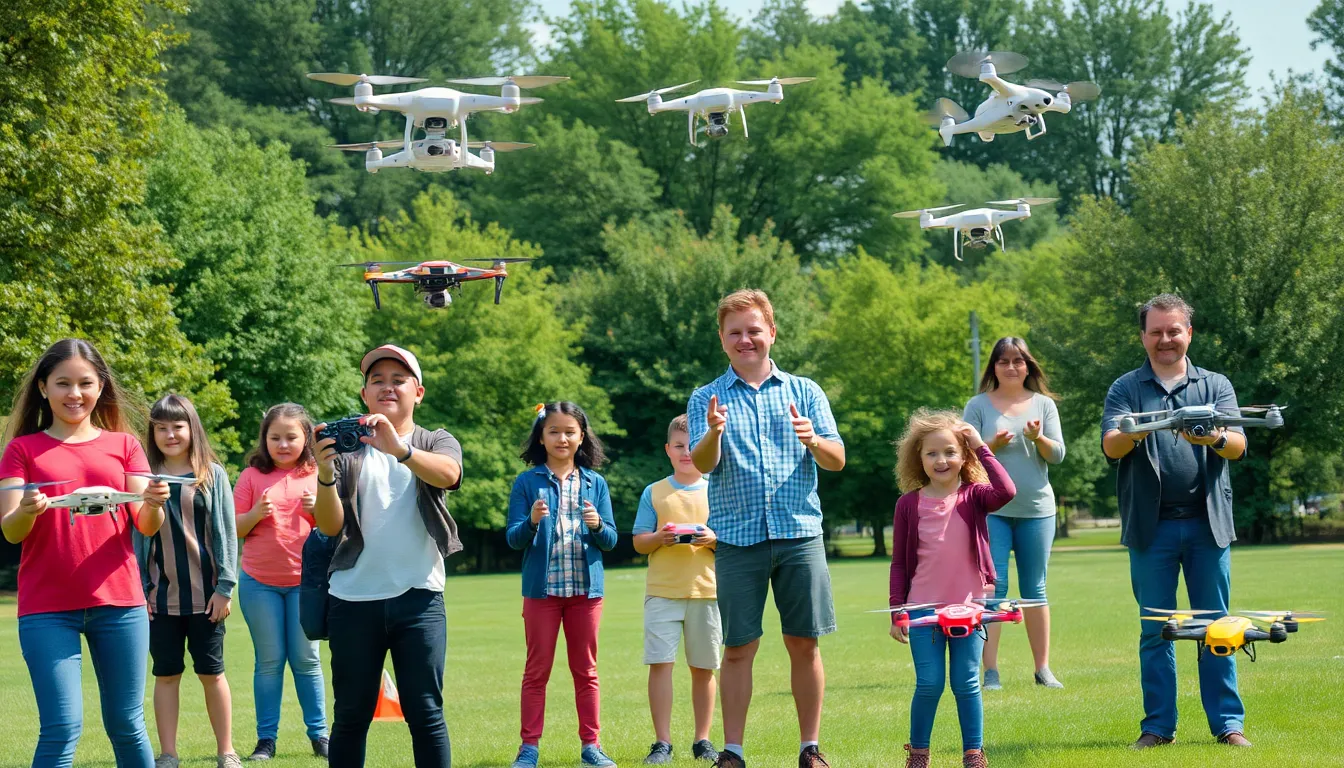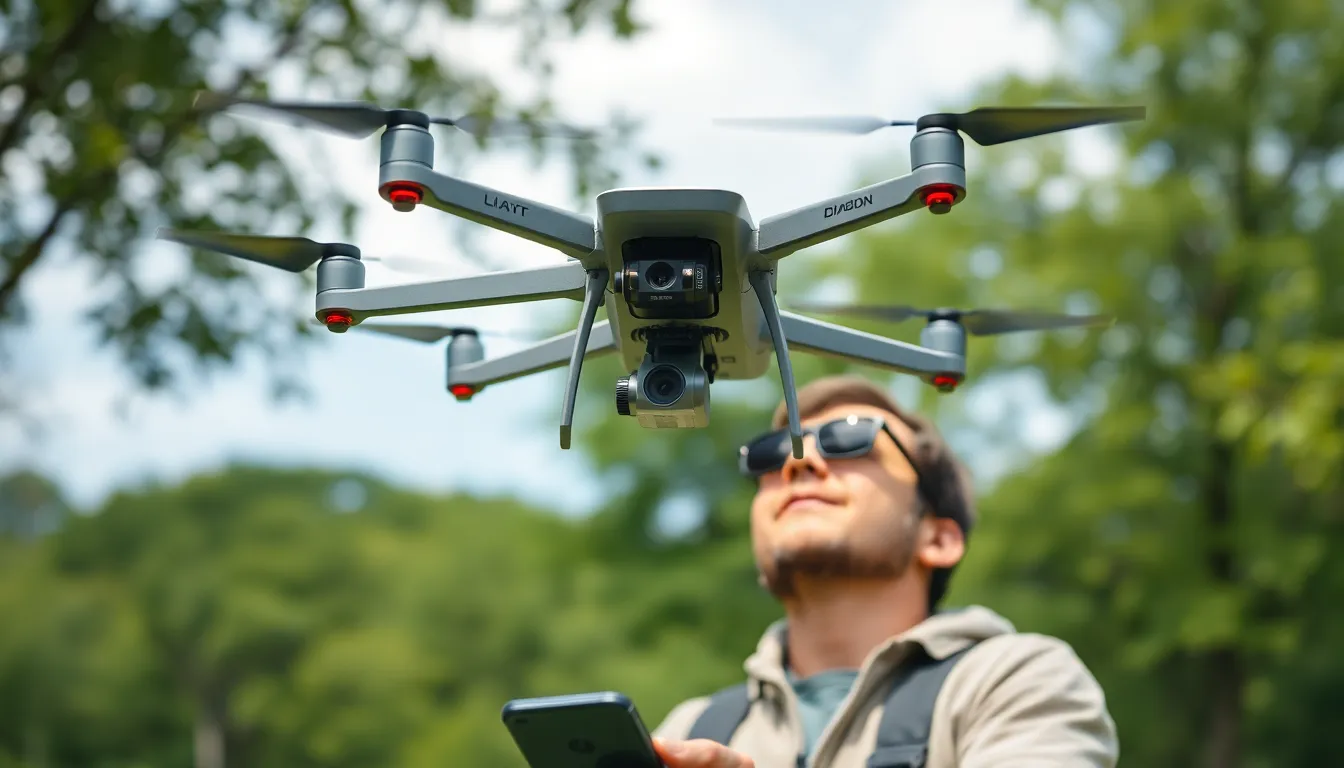Consumer drones have revolutionized the way people capture moments and explore the world from above. With their increasing popularity, these high-tech gadgets have become accessible to hobbyists and professionals alike. Whether it’s for stunning aerial photography, racing, or simply enjoying the thrill of flight, consumer drones offer a unique perspective that traditional photography can’t match.
As technology advances, the capabilities of these drones expand, making them more user-friendly and versatile. From built-in cameras to advanced navigation systems, today’s consumer drones are equipped to meet a variety of needs. This article delves into the exciting world of consumer drones, exploring their features, applications, and the impact they have on various industries.
Table of Contents
ToggleOverview Of Consumer Drones
Consumer drones, also known as UAVs (Unmanned Aerial Vehicles), encompass a range of models designed for personal and recreational use. These drones typically include features like high-definition cameras, GPS navigation, and automated flight systems, making them user-friendly and accessible.
Increasingly popular, consumer drones serve various applications. They enhance photography, allowing users to capture stunning aerial shots. They also support videography, offering new perspectives for film projects or social media content.
The market offers diverse drone options. Hobbyists can choose from affordable models with basic features, while professionals might invest in advanced systems equipped with high-resolution cameras and longer flight times. Common brands in the market include DJI, Parrot, and Autel Robotics, each with unique offerings suited for different user needs.
Technological advancements contribute to the appeal of consumer drones. Improved battery life now allows flight times exceeding 30 minutes. Enhanced stabilization technology helps maintain smooth video capture, minimizing camera shake. Additionally, integrated obstacle avoidance systems increase safety, allowing users to navigate complex environments effectively.
Regulatory frameworks also shape the consumer drone landscape. The FAA requires users to register drones weighing over 0.55 pounds, promoting safety and accountability. Compliance with regulations ensures responsible usage, particularly in populated areas.
Understanding the features, benefits, and regulations of consumer drones assists users in maximizing their potential. This knowledge empowers hobbyists and professionals to utilize drones effectively in both creative and practical applications.
Types Of Consumer Drones

Consumer drones are categorized into several types, each designed for specific uses and user experiences. Understanding these categories helps users choose the most suitable option for their needs.
Camera Drones
Camera drones are primarily designed for aerial photography and videography. Equipped with high-resolution cameras, they capture stunning images and videos from unique angles. Many models feature gimbals for stabilization, ensuring steady shots even during flight. Popular camera drones include the DJI Mavic series, known for portability and advanced features. Users can find options in various price ranges, catering to both beginners and professionals.
Racing Drones
Racing drones are built for speed and agility, often utilized in competitive drone racing events. These drones have lightweight frames and powerful motors, allowing for rapid maneuvers and quick acceleration. Designed for experienced pilots, they usually come as customizable kits, enabling users to modify components for optimal performance. Popular models include the Tiny Whoop series, favored for its easy-to-fly nature.
Toy Drones
Toy drones serve as an introduction to flying for children and beginners. These models are typically lightweight, user-friendly, and less expensive than professional counterparts. While toy drones may lack advanced features, they often include basic cameras and come in various designs. Companies like Holy Stone and Snaptain offer attractive options for young users, promoting learning and fun in flying.
Key Features To Consider
Choosing a consumer drone requires attention to specific features that directly affect flight performance, image quality, and overall user experience. Key attributes include battery life, camera quality, and flight range.
Battery Life
Battery life significantly impacts a drone’s flight time and usability. Most consumer drones offer flight times ranging from 15 to 30 minutes per charge. Models with higher-capacity batteries support extended usage, essential for capturing longer footage or completing expansive projects. Additionally, the option for additional batteries or quick charging capabilities enhances convenience for users engaged in extended sessions or professional workflows.
Camera Quality
Camera quality determines the visual output of the drone. Many consumer drones feature high-definition cameras with resolutions from 1080p to 4K, providing sharp, clear images. Advanced stabilization technology further improves footage by reducing shake during flight. Users interested in specific applications, such as professional filmmaking or landscape photography, should consider drones equipped with larger sensors and interchangeable lenses for greater flexibility in capturing diverse scenes.
Flight Range
Flight range indicates how far a drone can operate from its controller. Most consumer drones maintain a range between 1,000 to 5,000 meters, allowing access to expansive areas. Enhanced GPS navigation and signal transmission technologies can extend this range, offering reliable connectivity even in challenging environments. Users should evaluate their intended applications to ensure the selected drone supports adequate range for capturing desired locations or performing maneuvers effectively.
Popular Consumer Drone Models
Consumer drones come in various models tailored to different user preferences and requirements. Below are some popular options highly regarded for their features and performance.
DJI Mavic Series
DJI’s Mavic series stands out for its compact design, advanced technology, and high-quality imaging capabilities. Models like the Mavic Air 2 and Mavic Mini 2 offer 4K video resolution, intelligent shooting modes, and exceptional flight stability. Mavic drones feature a flight time of up to 34 minutes and a range of approximately 10 kilometers, making them suitable for both amateur and professional photographers. Enhanced obstacle avoidance systems further ensure safe navigation in complex environments.
Parrot Anafi
Parrot’s Anafi drone impresses with its lightweight structure and unique camera capabilities. It offers a 4K HDR camera with a 180-degree tilt gimbal, allowing for creative angles during shoots. With a flight time of up to 25 minutes and a range of 4 kilometers, Anafi caters well to both casual users and storyboard creators. Its portability and ease of use make it an excellent choice for travel photography and outdoor adventures.
Autel Robotics EVO
Autel Robotics’ EVO series combines robust build quality with high-performance features. The EVO Lite+ model boasts a 50MP camera capable of 6K video recording, ensuring stunning visual outputs. Users benefit from a maximum flight time of 40 minutes and a range of 12 kilometers. The drone’s advanced AI-powered subject tracking and intelligent flight modes offer hands-free operation, appealing to videographers and enthusiasts seeking creative flexibility during aerial shoots.
Regulatory Considerations
Understanding regulatory considerations is essential for safe and responsible drone operation. The Federal Aviation Administration (FAA) governs drone use in the United States, establishing specific guidelines to ensure public safety and airspace integrity. Operators must register drones weighing more than 0.55 pounds (250 grams) before flying them for recreational or commercial purposes.
Registration Requirements
- Recreational Use: Recreational drone users must complete the FAA’s online registration process, which costs $5. Registration lasts for three years. UAS (Unmanned Aircraft Systems) must display the registration number, directly marking it on the drone.
- Commercial Use: Commercial operators must hold a Remote Pilot Certificate under FAA Part 107, requiring successful completion of the FAA’s knowledge test. Ongoing compliance with Part 107’s operational rules is necessary for all commercial activities.
Operational Limitations
- Altitude Restrictions: Drones must fly at a maximum altitude of 400 feet (122 meters) above ground level to prevent interference with manned aircraft.
- No-Fly Zones: Users must avoid designated no-fly zones, including near airports, military bases, and sensitive areas. The FAA provides resources to identify restricted airspace.
- ** night Flying**: Night flights require additional permissions and must follow specific visibility and lighting requirements.
Local Regulations
- State and Local Laws: Many states and municipalities impose additional regulations on drone usage. Operators must research and comply with local laws regarding privacy, flight restrictions, and prohibited areas.
- Insurance and Liability: Some regions mandate liability insurance for commercial drone operators. Users should consider insurance options to mitigate risks associated with potential accidents or damages.
Adhering to these regulatory considerations contributes to the safe integration of consumer drones into national airspace and enhances public acceptance of drone technology.
Consumer drones have revolutionized the way individuals capture and experience the world around them. Their versatility and accessibility open up new creative avenues for both amateurs and professionals alike. As technology continues to advance, these drones will likely become even more integral to photography and exploration.
With a variety of models available, users can find the perfect drone tailored to their needs and preferences. Understanding the essential features and regulations ensures safe and effective use. As the market evolves, consumer drones promise to enhance visual storytelling and redefine recreational activities, making them an exciting addition to any enthusiast’s toolkit.




